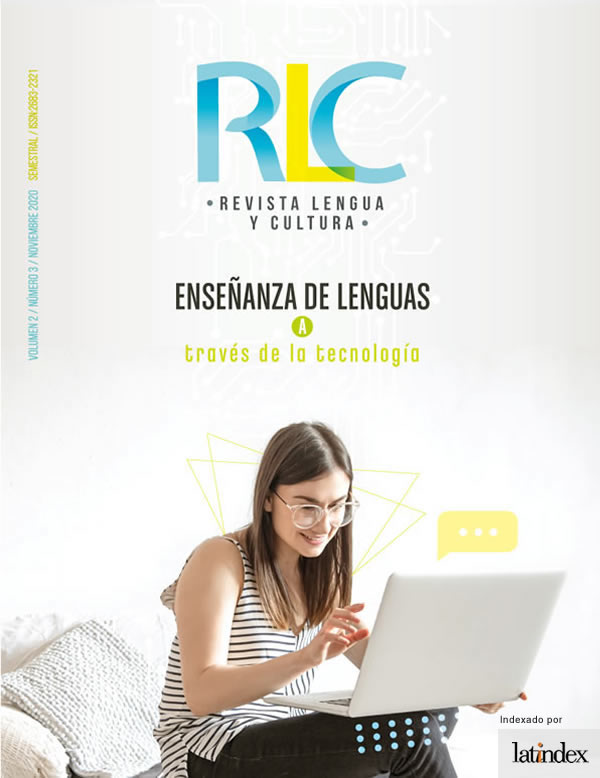Technological resources applied to the development of the Past Tense in English
Abstract
Linguistic awareness of the verbal Past Tense in English represents a complex point in the learner. It is understood that in the process and access to English as a target language, there are diverse representations of error that are considered transitory in nature. This research proposes the use of technological resources applied to the learning and development of the verbal Past Tense as evidenced by the analysis, classification, and description of learners written errors from the Core Curriculum at the Language Faculty from the Autonomous University in Baja California. Furthermore, the proposal is also grounded on the results of the survey that revealed the learners´ perception towards the use and preference of technological resources. This research is mixed methods, descriptive and a non-experimental study.
Downloads
References
Adell, J. (1997). Tendencias en educación en la sociedad de las tecnologías de la información. EDUTEC, Revista Electrónica de Tecnología Educativa(7). Obtenido de https://nti.uji.es/docs/nti/Jordi_Adell_EDUTEC.html
Akbar, A. (2012). Error Analysis and Second Language Acquisition.Theory and Practice in Language Studies, 2(5), págs. 1027-1032. Obtenido de https://pdfs.semanticscholar.org/2902/a09fba854bdbcfdeeb92a6591c99b5f918ab.pdf
Bialystok, E. (1988). Levels of Bilingualism and Levels of Linguistic Awareness. Developmental Psychology, 24(4), 560-567. Obtenido de https://pdfs.semanticscholar.org/9957/e8524586a59c19b1c1f149106d8444a489d3.pdf
Bolitho, R., Carter, R., Hughes, R., Ivanic, R., Masuhara, H., & Tomlinson, B. (julio de 2003). Ten questions about language awareness. ELT Journal, 57(3), 251-259. Obtenido de http://sayqeeh.com/j/sade/4_language_awareness.pdf
Beatty, K. (2010). Teaching and Researching: Computer-Assisted Language Learning. London: Pearson Education Limited. Obtenido de http://englishlangkan.com/produk/E%20Book%20Teaching%20and%20Researching%20CALL%20Ken%20Beatty%202011.pdf
Canale, M. (1995). De la competencia comunicativa a la pedagogía comunicativa del lenguaje. Competencia comunicativa : documentos básicos en la enseñanza de lenguas extranjeras, 63-82. Obtenido de https://dialnet.unirioja.es/servlet/articulo?codigo=574838
Chapelle, C., & Hegelheimer, V. (2004). New perspectives on CALL for second language classrooms. The language teacher in the 21st century, 299-316.
Corder, S. (1967). The Significance of Learner's Errors. Heidelberg: Julius Groos Verlag. Obtenido de https://files.eric.ed.gov/fulltext/ED019903.pdf
Dulay, H., Burt, M., & Krashen, S. (1982). Language two. New York: Oxford University Press. Obtenido de https://www.academia.edu/7416848/_EBOOK_Language_Two_by_Heidi_Dulay_Marina_Burt_and_Staphen_Krashen_1982_source_BookFi.org
Egbert, J., & Petrie, G. (2006). CALL Research Perspectives. New York: Routledge.
Fasold, R., y Connor-Linton, J. (2013). An introduction to language and linguistics. Spain: Cambridge University Press. Obtenido de https://kupdf.net/download/an-introduction-to-language-and-linguistics_5af870f6e2b6f5d7353d7551_pdf
Instituto Cervantes. (2002). Marco Común Europeo de Referencia para las Lenguas: Aprendizaje, Enseñanza, Evaluación. España: Ministerio de Educación, Cultura y Deporte, Subdirección General de Cooperación Internacional, para la edición impresa en español. Recuperado de http://cvc.cervantes.es/obref/marco
González, D., & Ortíz, M. (2016). Storyboard como herramienta de apoyo didáctico en el desarrollo de competencias investigativas en estudiantes de educación superior. Caso: delimitación del problema de investigación. En A. Méndez, & D. Gutiérrez, Estrategias de enseñanza y aprendizaje. Una mirada desde diferentes niveles educativos (pág. 144). Durango: Red Durango de Investigadores Educativos A. C. Obtenido de http://iunaes.mx/inicio/wp-content/uploads/2017/02/Libro-9.pdf
Hubbard, P. (2009). Computer Assisted Language Learning: Critical Concepts in Linguistics. New York & London: Routledge.
James, C. (2013). Errors in Language Learning and Use: Exploring Error Analysis. London: Routledge. Obtenido de https://b-ok.lat/book/3434470/9c9215?regionChanged
Levy, M., & Stockwell, G. (2006). CALL dimensions: options and issues in computer assisted language learning. Language, learning and technology, 11(2), 27-30. Obtenido de https://www.researchgate.net/publication/237710614_CALL_dimensions_options_and_issues_in_computer_assisted_language_learning
Lyster, S. (2001). Language and reading-Development and disorders. En S. Lyster, Special education needs education: An introduction. Unipub.
Martín, E. (2012). Presente y futuro de la enseñanza de lenguas asistida por ordenador: ¿El final de una era? Revista de Lingüística y Lenguas Aplicadas, 7, 203-212. Obtenido de https://www.researchgate.net/publication/259981090_Presente_y_futuro_de_la_ensenanza_de_lenguas_asistida_por_ordenador_El_final_de_una_era
Navarro, W. (2011). Las TIC en el sistema educativo colombiano. REVISTA VINCULOS, 8(1), págs. 150-156. Obtenido de https://revistas.udistrital.edu.co/index.php/vinculos/article/view/4175/5835
Richards, J. (1975). Error Analysis: Perspectives on Second Language Acquisition. London: Routledge. Obtenido de https://www.taylorfrancis.com/books/9781315836003
Richards, J., y Reppen, R. (2014). Towards a Pedagogy of Grammar Instruction. RELC Journal, 45(1), 5-25. Obtenido de https://www.professorjackrichards.com/wp-content/uploads/Grammar-instruction.pdf
Roehr, K. (2007). Metalinguistic Knowledge and Language Ability in University-Level L2 Learners. Applied Linguistics, 29(2), 173-199. Obtenido de https://core.ac.uk/download/pdf/4188071.pdf
Roldán, E. (1979). La técnica del análisis de errores. Documentos Lingüísticos y Literarios, 3, págs. 47-52. Obtenido de http://www.humanidades.uach.cl/documentos_linguisticos/docannexe.php?id=182
Rustipa, K. (2011). Contrastive Analysis, Error Analysis, Interlanguage and the Implication to Language Teaching. Ragam Jurnal Pengembangan Humaniora, 11(1). Obtenido de https://pdfs.semanticscholar.org/255e/bdf90f8353aac8347ec8fcbe7e0f66fa92f2.pdf
Sañudo, J. (2013). La enseñanza de la gramática y el uso del corrector gramatical (grammar checker). UNED, Facultad de Filología. Madrid: Facultad de Filología, UNED. Obtenido de https://eprints.ucm.es/27320/1/tfm.pd
Copyright (c) 2020 Ruben Octavio Quintero Espinoza, Jesús E. Fong-Flores, Laura E. Fierro-López , Tatiana E. Galván-De la Fuente

This work is licensed under a Creative Commons Attribution-NonCommercial-NoDerivatives 4.0 International License.













